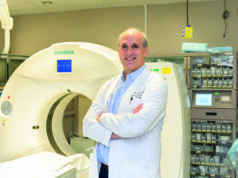This advertorial is sponsored by Sirtex Medical, is only available in selected countries and geographies.

The SUMM90YT conference (23 February, Frankfurt, Germany)—hosted by Sirtex—gathered leading experts in selective internal radiation therapy (SIRT) utilising SIR-Spheres Y-90 resin microspheres (Sirtex Medical). The conference facilitated discussion and debate on the appropriate selection of patients with unresectable hepatocellular carcinoma (HCC) and metastatic liver tumours from primary colorectal cancer (mCRC) refractory to or intolerant of chemotherapy, as well as the latest technical advancements in the field.
Organised into three distinct sessions— SIRT in HCC, SIRT in mCRC, and key technical considerations—the SUMM90YT programme fostered dialogue through a modelled multidisciplinary tumour board. Speaking to Interventional News, moderator Macarena Rodríguez-Fraile, nuclear medicine physician (Clínica Universidad de Navarra, Pamplona, Spain) and speaker Irene Bargellini, interventional radiologist (Cuneo Hospital, Cuneo, Italy) reflect on their key takeaways from the conference.
The day’s first session was dedicated to HCC, as speakers including surgeon Claire Goumard (University Hospital Pitié Salpêtrière, Paris, France), surgeon Pietro Addeo (Hôpital de Hautepierre, Strasbourg, France), radiation oncologist Maria Hawkins (University College Hospital, London, UK), Bargellini herself, and others, described what is known to date regarding research and treatment options. Predominantly, speakers used patient cases to illustrate the use of SIRT for bridging or downstaging to transplantation and downsizing to resection, inducing contralateral hypertrophy, and explored the potential of combining SIRT with systemic therapies.
In this segment, Bargellini presented on the applicability of SIRT for intermediate to advanced stage HCC. “Thanks to the refinement of indications and the development of personalised dosimetry, SIRT has become a highly appealing and potentially curative treatment across all stages of the Barcelona Clinic Liver Cancer (BCLC) staging system for HCC, evidence showing most benefits in early-stage HCC, in patients with single lesions, to the advanced stage, in patients with portal vein tumour thrombosis,” she told Interventional News. Bargellini added that the speakers in the morning session suitably described the “value in downsizing tumours with SIRT or to induce contralateral hypertrophy—which is now fully demonstrated—making it a valid tool to convert patients to surgery”.
In agreement with Bargellini, Rodríguez-Fraile detailed the “progressive expansion” of SIRT from advanced HCC to earlier stages, through its potential to reclassify disease status. “Growing evidence of the benefits of using SIRT as a facilitator of surgery were shown during SUMM90YT. This was either to reduce tumour size for resection or to bridge/downstage for liver transplant, allowing for surgery that was initially inadvisable. SIRT can also be performed to increase the future liver remnant evaluating the biology of the tumour through the “test of time”, she said.
“Numerous trials and recent prospective registries from the USA and Europe—namely, RESiN (Radiation-emitting SIR-Speres in non-resectable liver tumor) and CIRT (CIRSE registry for SIR-Spheres therapy)—have demonstrated the safety and efficacy of SIRT with Y-90 resin microspheres in HCC patients,” Rodríguez-Fraile conveyed. “Speakers looked at the real-world evidence gained in these registries and concluded that SIRT is a safe and effective bridging therapy.”
Clinical characteristics must define multidisciplinary decision-making
In the programme segment which followed, speakers including medical oncologist Elena Elez (Vall d’Hebron University Hospital, Barcelona, Spain), interventional radiologist Franco Orsi (European Institute of Oncology, Milan, Italy) and surgeon Simeon Ruiter (University Medical Center Groningen, Groningen, The Netherlands), among others, introduced SIRT for chemo-intolerant or -refractory mCRC patients.
Here, the multidisciplinary panel and audience-member participants concluded that SIRT “can have a role” in controlling mCRC in advanced settings, Rodríguez-Fraile explained, as SIRT can be used to enable surgery through contralateral hypertrophy induction or by applying radiation segmentectomy. “Consensus was made that SIRT can be used to maximise metastases control to improve progression-free survival and overall survival, as well as for chemotherapy breaks, and chemo-intolerant patients,” she said.
“Although we still need better designed and well-conducted clinical trials,” Bargellini said, “there is clear evidence that SIRT is safe and effective for mCRC and should be a part of our armamentarium, and that came across at SUMM90YT.” Expanding on this conclusion, she detailed how speakers in this session exemplified how radiation segmentectomy is able to induce a “complete and durable” response in patients who are unfit for surgery or excluded from ablation, and further, how radiation lobectomy may play a role as a conversion strategy in unresectable patients.
Overall, Bargellini stated that to be “actively integrated” into the modern therapeutic landscape for mCRC, “adequate patient selection needs to be mandatory to avoid unwanted toxicities and futile treatments”. In Rodríguez-Fraile’s recollection, this was a central takeaway of the session, the multidisciplinary panel placing emphasis on decerning clinical characteristics when selecting appropriate patients for treatment. She emphasised however, that patient selection can be optimised through tailored profiles A, B and C. Patients in these profile groups she described as: chemo-intolerant with desire for more quality of life (QoL) (A), chemo-refractory, but willing to undergo treatment (B), and aggressive liver-dominant disease with poor prognosis (C).
Summarising the panel’s thoughts, Rodríguez-Fraile noted that patient and tumour features—including tumour biology, personalised dosimetry and patient preference—should be considered above all when considering SIRT for mCRC.
Technical advancements in personalised dosimetry
In the final session of the day, speakers including nuclear medicine physician Michael Kreißl (Universitätsklinikum Magdeburg, Magdeburg, Germany), interventional radiologist Manuel González-Leyte Hospital General Universitario Gregorio Marañon, Madrid, Spain), and interventional radiologist Roberto Iezzi (Policlinico Universitario Fondazione Agostino Gemelli, Rome, Italy) provided various insights into the technical facets of SIRT, offering practical guidance on optimal usage strategies.
Rodríguez-Fraile recalled how prominent focus was placed on dosimetry and microsphere distribution. She explained that microsphere distribution is not only related to blood flow and parameters that the interventional radiologist has control over, such as injection velocity, or type of catheter used, but also to the number of microspheres injected and the specific activity per sphere.
“It has been demonstrated that microsphere distribution has a direct impact on dosimetry such as radiobiological effect, e.g. toxicity and efficacy,” she said. To achieve this flexibility, Rodríguez-Fraile noted that the FLEXdose Delivery programme by Sirtex enables modulation of microsphere properties (number of microspheres and specific activity per sphere) and can facilitate tailored, patient-specific treatments.
“Depending on the goal of the treatment, the volume of the liver to be treated, and the tumoral characteristics (vascularity, size, volume), it is possible to use a different day of calibration vials to maximise the effect. For example, for the same prescribed activity, as the precalibration day increases, the activity per sphere is greater and the number of spheres to be injected will be smaller. This type of vial can be especially useful in selective treatments, as it reduces the risk of reflux and allows greater activity to be administered,” Rodríguez-Fraile explained.
The importance of the work-up phase to precisely plan each treatment was foregrounded at during the session, Bargellini noted. “Today, we know that personalised dosimetry, based on tumour type, extension and treatment goal, is key to achieve high local control and reduce hepatotoxicity.”
“Discussion at SUMM90YT called for a standardised and streamlined workflow, which has been seen through the flexibility of SIR-Spheres in sparing time by exploiting the potential of single-day or single-stay procedures, while better tailoring our treatments to each patients’ clinical and anatomical conditions.”
Processing points given throughout SUMM90YT, Rodríguez-Fraile believes the future of SIRT will be defined by personalisation, combining optimal clinically informed selection of patients with targeted dosimetry-driven treatments. For Bargellini, a central takeaway for the future was the “strong potential synergistic effect” between SIRT and immunotherapy, the integration of which will be better understood via the results of ongoing studies, she states.
As these promising applications develop through research, Bargellini believes that implementation of a standardised treatment protocol for SIRT is required to reach landmarks in its use, to increase safety and efficacy, and to broaden the number of centres that have access to this technology.











